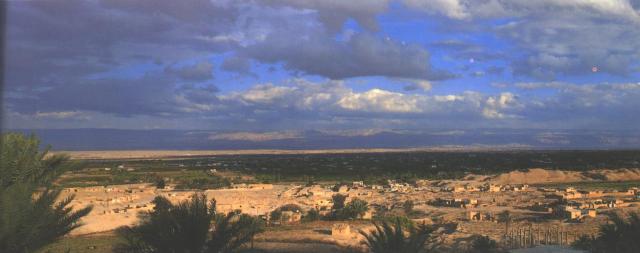
| The origin of the name “Jericho” is from the Semitic language. It is a Canaanite word that means “city of the moon.” The word is derived from yeriho or yarah. According to Anis Freiha, the Canaanite God Yarah gave its name to Jericho, called Ariha in Arabic. Jericho is the Biblical name, “city of palm trees,” while its Arabic name Er-Riha means “perfume.” Jericho is known for its subtropical climate that makes it an extraordinary garden, ideal for winter vacation. It was used as a resort by the wealthy people of Jerusalem, Bethlehem, and Ramallah who wished to escape the harsh winter. In ancient times, there were isolated farms on the valley’s fertile land. Cleopatra was undoubtedly the most famous of Jericho’s landowners, her estate was a gift from Mark Antony in 35 BC. Jericho is over 800 feet below sea level, making it the lowest inhabited place on earth. It’s the first walled city in the world and it was one of the most important cities in the country in the time of Jesus and John the Baptist. Jesus passed through Jericho on his way to Jerusalem and John the Baptist baptized his believers in the Jordan River.This year, Jericho, made famous in the Bible, and one of the earth’s lowest and oldest inhabited cities, has launched a year-long celebration of its 10,000th anniversary. In the Bible’s Old Testament the book of Joshua (6:1-16) relates how the ancient Israelites captured Jericho by following God’s instruction to walk round the city for seven days sounding a ram’s horn leading to the collapse of its walls. Deir Hajla: The monastery is outside the city of Jericho. It was founded in 455 CE by St. Gerasimus, who, according to legend befriended a lion that lived by his side until he died. The Tree of Zacchaeus: Jesus met with the chief publican, Zacchaeus, who repented after Jesus came to his house. Zacchaeus, a man of small stature, climbed a sycamore tree in order to get a better view of Jesus, who was surrounded by a large crowd. Jesus visited his home, and as a result Zacchaeus repented and gave half of his property to the poor and promised to compensate those whom he had exploited. The Mount of Temptation: The Monastery, perched on the side of the mount of temptation, offers a stunning panorama over the Dead Sea, Jordan Valley, and Jericho. On this mountain Jesus fasted for 40 days and was tempted by the devil. During the Byzantine days, numerous Christian hermits settled in the caves around the monastery. The monastery dates from the 12th century. It has two churches associated with the temptation of Christ: one constructed near a cave, the other on top of the mountain. The Sugar Mills: Jericho’s sugar mills(Tawahin al-Sukkar) date back to the prosperous reign of the Umayyads. Later, the Crusaders restored them and exported Jericho’s sugar to Europe. Hisham’s Palace (Khirbet al-Mafjar): The Hisham palace was one of the most impressive country residences of the Omayyad period; archaeologists call it “the Versailles of the Middle East.” It was built at the beginning of the eighth century by Omayyad Caliph Hisham Ibn Abd al-Malik (724-743), only to be partially destroyed 20 years later in an earthquake. Herod’s Winter Palace (Tel Abu al-‘Alayiq): This elevated spot has been home to palaces during several historical periods. The Hellenistic era saw the construction of what are known as twin palaces. Herod built no less than three in all: the first, when the famous Egyptian queen Cleopatra reigned over the whole Jordan Valley; the second, after an earthquake and the third, after Cleopatra’s suicide, was built with hard mud brick made from clay mixed with sand, because it had become clear that the climate in Jericho was not suited for Rome’s building materials. Only the traditional Roman baths were built in the Roman style. Nabi Musa: This sanctuary in the desert was erected under Mameluke sultan Baybar (1260-1277). Muslim tradition has it that this is the burial place of the prophet Moses (Nabi Musa). In the 1820s, the Ottomans began a popular festival at the site. During the festival, Palestinians from Haifa, Jaffa, Nablus, and Jerusalem regularly partook in the celebration, sending delegations of dancers, poets, and artisans to represent their cities and villages.In modern history, the site became a gathering place for the politically active. As a result the site was closed in 1937 by the British government. Later, it was transformed into a Jordanian, then an Israeli military camp. Today, a local Palestinian family lives at the sanctuary. The Dead Sea: It lies at the lowest point of the great Afro-Syrian divide (the Great Rift), over 400 meters below sea level. The surface of the Dead Sea is the lowest point on earth, its base being 800 meter below sea level. Swimming in the Dead Sea is a unique experience; because there is so much salt in the water, it is easier to float than to swim. The water can be extremely painful for the eyes or any open cuts. Tel es-Sultan (ancient Jericho): Tel al-Sultan is a mound northwest of the present city. Archeologists believe that the city was heavily fortified and had 2,000 inhabitants. The fortress built at Tel al-Sultan stretched over six acres and had 20 foot walls. The public buildings had arched gates and courtyards and stone columns. Unearthed skulls of women had head dresses similar to the one still worn by rural women in Palestine. Tombs included household items such as weaving looms, clothes, beddings, mats, tables, chairs, plates, jugs, copper basins, water jars, pots and clay ovens. Family tombs contained traces of food, cooked or grilled mutton , and the remains of cereals, pomegranates, and raisins, next to the bodies. Ein al-Sultan (Spring of Elisha): According to local lore, one of the kings of Jerusalem had his eyes poked out here by the Babylonians – thus the Arab name, “Sultan’s eye.” The Bible tells of the prophet Elisha healing/cleansing the polluted water of the spring at the request of people of Jericho. The spring still provides an important water source for the people of Jericho and their farmlands.Jericho is an extremely interesting place for the foreign visitors and Palestinians alike because of its long history, rich array of cultural artifacts, and stunning sights in which desert and oasis converge. And it’s also heartwarming to visit it because of the nice and hospitable people, the (citrus!) fruits, as well as its pleasant and mild climate during wintertime. |
| Sources Used and Consulted: | |
| – Palestine with Jerusalem, Henry Stedman, England: Bradt Publications, c2000 | |
| – Palestine: a guide, Mariam Shahin, Massachussetts: Interlink Books, c2005 | |
| – Palestine & Palestinians: guidebook, Beit Sahour: Alternative Tourism Group, c2005 | |
| – Dances with the Gods, Wafa Stephan Tarnowski, Nicosia: Rimal Publications, 1997 | |
| – 2000 years of pilgrimage to the Holy Land, Edited by Eliezer Sucks TelAviv: Cordinata, c1998 | |
| – The Holy Land from the Air, Amos Elon, Jerusalem: The Domino Press, 1987 | |
| – Around the Holy City: between Jerusalem, Bethlehem, and Jericho, Amnon Ramon, Jerusalem: The Jerusalem Institute for Israel Studies, c2000 |

